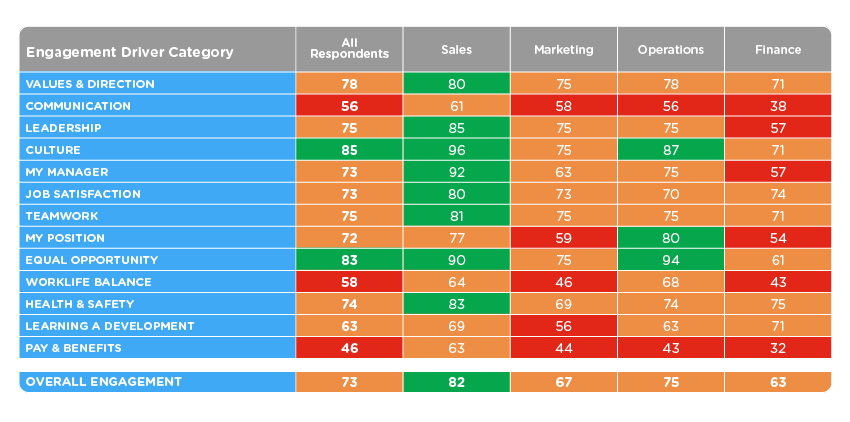
One of the easiest ways to know whether it is Monday or not is to spend some time on social media. You will undoubtedly see a series of memes cursing the start of another working week. Sure, I can see the funny side in most of them, but what is most striking is the number of likes, shares and comments on these flagships of disengagement at work.
Deloitte research1 found that engagement requires an empowering and highly inclusive work environment. However, such a level of inclusivity is a rarity; only 11% of companies have such work environments. It comes as little wonder then that this same research found 85% of executives rated employee engagement as a top priority – even though only 46% of companies are prepared to handle the challenges that employee engagement presents.
What is Employee Engagement
Employee engagement is not a measurement of whether someone is happy at work, but rather how psychologically invested they are at work. While engagement is often seen as a term which can be used interchangeably with culture, the two are unique and independent concepts, aptly fitting Deloitte’s definition.
Culture describes ‘the way things work around here’, while engagement describes ‘how people feel about the way things work around here.’1
The ripple effect disengaged employees can have on a business is significant, which highlights the need to see employee engagement as a task which is never complete; it is a focus which needs to continue throughout the entire employment lifecycle. When the process of engagement ceases, employee turnover is likely – regardless of whether the employee or employer drives it.
Approximately two-thirds (64%) of senior executives in the abovementioned Deloitte research stated that their companies use employee engagement surveys. Undertaking systematic and confidential employee engagement surveys can provide a platform for your team to openly and honestly share their thoughts and feedback about their work environment. Moreover, when designed, implemented and analysed effectively they may reveal risks and opportunities, otherwise unknown by management.
Sample Report Element: Evans Faull Employee Engagement Survey
Practical Steps to Ensuring Engagement
When meeting a potential employee for the first time, employers often forget that a high-quality candidate will be assessing the business at the same time you are evaluating them. The role of the employer at this point is to investigate the goals and values of the individual to determine if their priorities align with the organisations. There is no point in selecting the ‘pick of the bunch’ if they are not heading in the same direction as the business. Strategic alignment right from the beginning is an essential element in employee engagement.
Author and Motivational Speaker Simon Sinek believes:
If you hire people just because they can do a job, they’ll work for your money. But if you hire people who believe what you believe, they’ll work for you with blood, sweat and tears.
The analogy might be a little dramatic, but the message is spot on. Your employees may not need to be passionate about your product as such, maybe it’s the satisfaction they get from closing a sale, or implementing conflict resolution tactics to resolve a customer issue, or developing new your corporate governance initiatives. Regardless, there needs to be a strong link that brings you both together in the first place as there will be challenges over the journey, like in any relationship, and that alignment that first brought you together will become the anchor.
Once an appointment has been made, the onboarding and training program for a new employee will also set the foundations for future engagement. The employer must demonstrate how the work of the employee will have a positive impact on the organisation. The employee needs to see how they fit in the big picture; why their work matters.
During onboarding, allow the employee the opportunity to voice concerns and offer ideas. Encourage them to ask questions to ensure they move forward with clarity and without reservation.
I once had a job where I knew after the first hour on the first day that I had made a mistake. The CEO took me for coffee and I had barely had my first sip before he told me I needed to terminate an employee by the end of the day – there were only 6 people in the office! Engaged? Not quite, I left after 4 weeks…
In many cases, position descriptions will have key performance indicators which are usually reviewed and established annually. To ensure the employee remains engaged, the Manager should be checking in regularly, offering support and guidance, not waiting until the anniversary of their employment. Additionally, it may be necessary to establish more regular bite-sized goals contributing to the sense of success and motivation of the employee. When employees lack clear direction, they become confused and frustrated, directly impacting on their engagement levels.
To encourage employee independence, mistakes should be embraced, and learnings discussed. This will only be effective if the Manager and organisation support employees during these periods and adopt a shared sense of responsibility.
The role of the manager or supervisor is essential to maintaining employee engagement. The manager is seen as the representative of the CEO or business owner and therefore, their ability to engage with employees is critical.
Here are some tips for Managers on engaging with employees;
- Communicate – keep them informed about company and department activity. Tell them what’s required simply, concisely and effectively.
- Take an interest – what is their background, what are their hobbies, can they cook, do they drive or take transport to work?
- Support – lift them up when required, realise they have issues outside work that will impact them at various times.
- Mentor and develop – build their strengths and capabilities and assist in overcoming skill gaps.
- Acknowledge achievements – give praise and recognition as much as possible.
- Celebrate – birthday cakes, share special events like engagements, births, marriages.
- Don’t micromanage – allow them time to discover and participate, people are not robots and need the freedom to learn.
- Be fair – employees expect fairness, equality and to be treated with respect. A failure to do this will result in alienated and resentful individuals.
Another key driver for engagement is reward and remuneration. An employer once said to me, ‘what's the point of asking employees about their pay, they are never going to say they are satisfied…’. The reality is, if your employees believe they are underpaid, they will feel undervalued and are likely to become disengaged. It’s not an issue you can put your head in the sand about.
When considering above award payments, the organisation should ensure employees are paid at market value or in accordance with industry benchmarks. Failure to do so is likely to result in employee turnover. In the event the organisation has financial constraints or funding implications, this should be clearly communicated to the employee so that expectations can be managed accordingly. In many cases where a Manager or other leaders in the business demonstrate the strategies recommended above, loyalty and positive workplace culture tend to edge out payment as a priority.
I remember being told in my own pre-wedding counselling session about the importance of communication in the relationship. How couples need to talk issues through, listen to each other and try and see things from each other’s perspective. This lesson could be applied to any employer/employee relationship. If in doubt about an employee’s motivation and engagement levels, talk to them! Ask them what they need or want, you can then consider whether you can meet their expectations or not, but you won’t know unless you start the conversation.
1. Deloitte University Press, Global Human Capital Trends 2016 - The new organization: Different by design, 2016.
